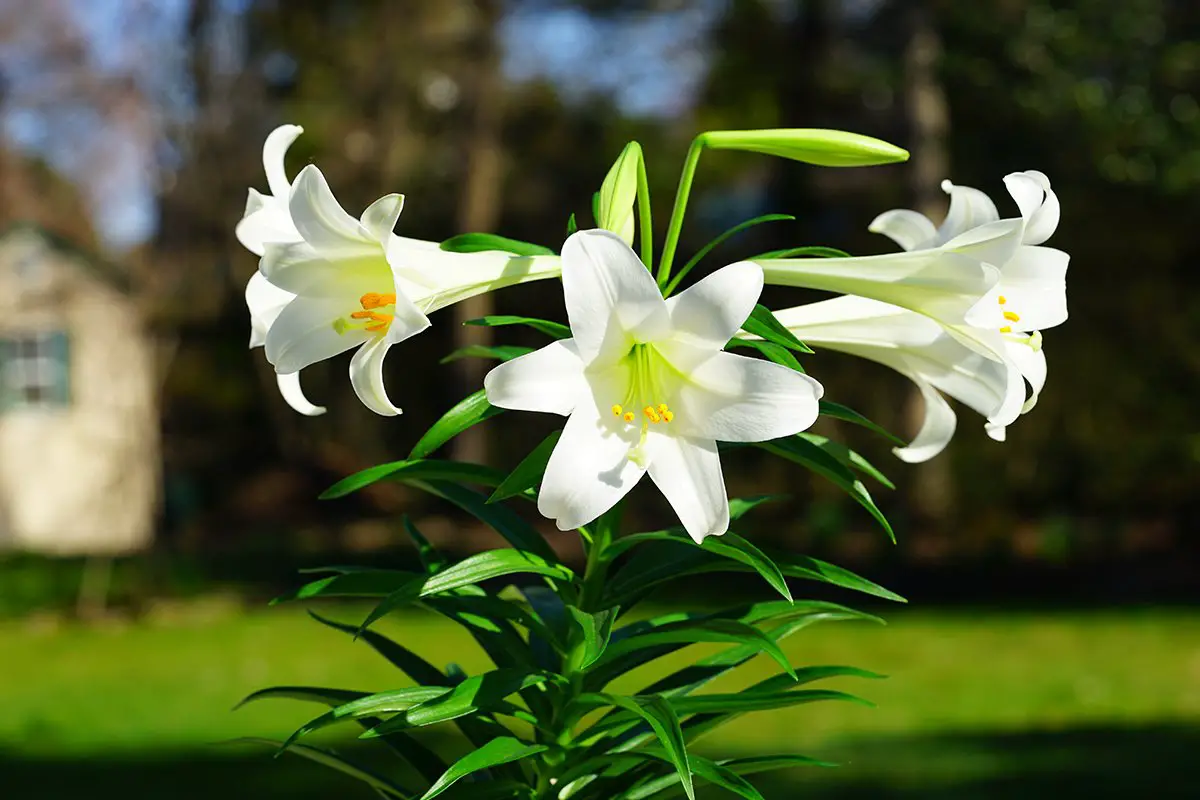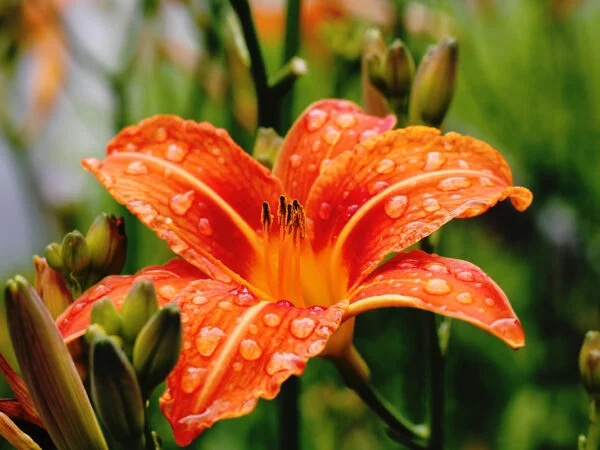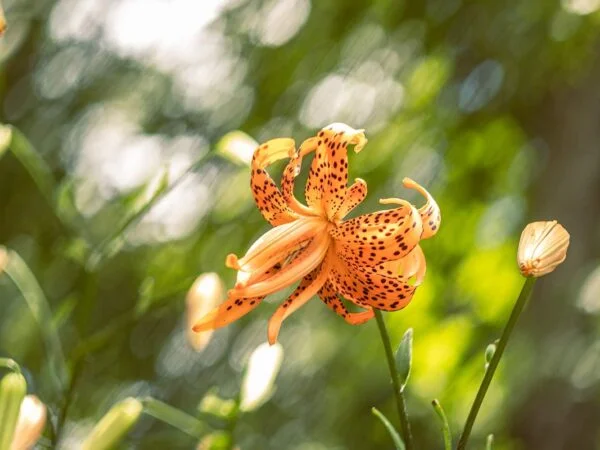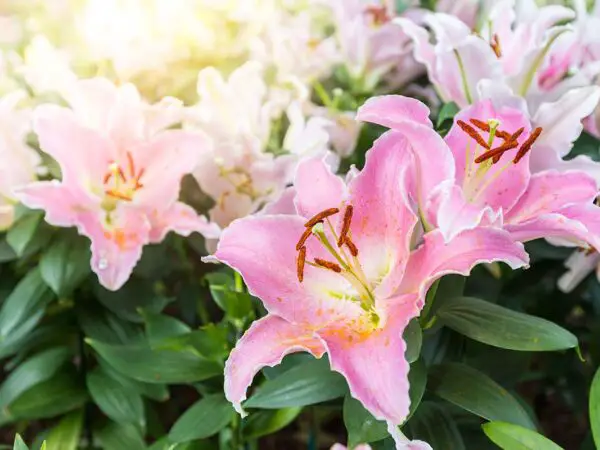Are you ready to add a touch of elegance and purity to your garden or home with lilium longiflorum, a stunning perennial? Look no further than these beautiful spring bulbs. Many gardeners adore these Easter lily plants, as they symbolize hope, new beginnings, and the essence of the holiday season.
Growing Easter lilies, also known as lilium longiflorum, may seem daunting to many gardeners at first. However, with the right techniques and a little bit of care, you can enjoy these fragrant flowers in all their glory. Whether you're an experienced gardener or a novice plant enthusiast, understanding the basic requirements of these spring bulbs is crucial for their successful cultivation.
Read More:
- Easter Lily Indoor Care: Planting, Growing, and Tips
- Easter Lily Care: A Complete Guide
- Giant Lilies – Buy Orienpet Lily Bulbs and Uncover Their Beauty!
- Exploring the Unique Characteristics of Lily Leaves: A Comparative Analysis
To ensure the growth and longevity of your lilium longiflorum, also known as easter lilies, it's important to provide them with proper care and attention. From choosing the right location to watering and fertilizing techniques, every step plays a vital role in their overall well-being. By mastering these essential practices, you'll be rewarded with vibrant flowers that will leave everyone in awe for years to come, especially during the holiday season and fall.
So let's dive into the world of fall holiday easter lilies—unraveling their secrets one petal at a time. Get ready to embrace nature's gift as we embark on this delightful journey together in the US!
Choosing the Right Location for Outdoor Easter Lily Plants
Choosing the right location in the fall plays a crucial role in the growth and overall health of your Easter lilies. The place where you decide to plant them can significantly impact their ability to thrive and produce beautiful blooms.
Selecting a Suitable Place
- Full Sun or Partial Shade: Easter lilies prefer locations that receive full sun or partial shade throughout the day. These plants thrive in bright sunlight but can also tolerate some shade. When deciding on a spot, ensure that it receives an adequate amount of sunlight based on these preferences.
- Well-Draining Soil: To prevent waterlogging and root rot, it is essential to choose an area with well-draining soil for your Easter lilies. These plants do not fare well in overly wet conditions, so avoid areas prone to standing water or heavy clay soil. If necessary, improve drainage by incorporating organic matter into the soil before planting.
- Avoid Competing Trees and Shrubs: When selecting a location for your outdoor Easter lilies, keep in mind that they should not be planted near trees or large shrubs that may compete for nutrients and moisture from the soil. The presence of nearby vegetation can hinder the growth of your lilies and affect their ability to absorb essential resources.
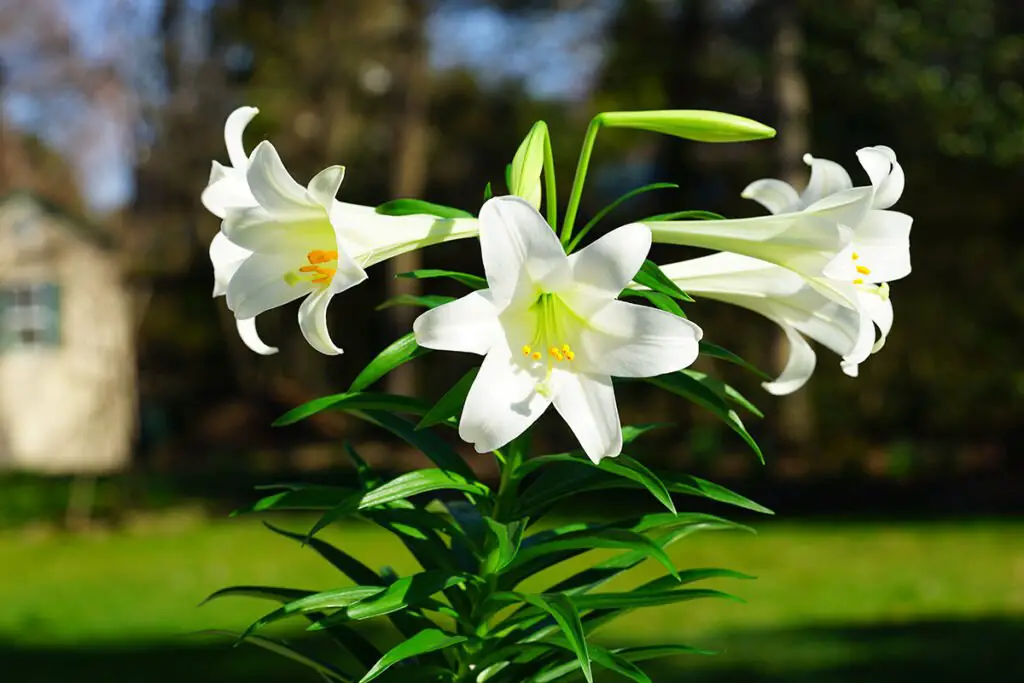
Factors to Consider
- Wind Protection: Strong gusts of wind can cause damage to delicate Easter lily stems, leading to bent or broken flowers. Therefore, it is important to consider wind protection when choosing a location for your plants. Placing them near structures such as fences or walls can help create a barrier against strong winds and safeguard their fragile stems.
- Adequate Spacing: Providing sufficient spacing between each Easter lily plant is vital for optimal growth. Adequate spacing allows for proper air circulation, reducing the risk of diseases that thrive in damp and stagnant conditions. Aim to keep a distance of at least 12 inches between each plant to ensure they have enough room to flourish.
Understanding the Blooming Cycle of Easter Lilies
Easter lilies, those beautiful white flowers that symbolize renewal and rebirth during the Easter season, have a blooming cycle that is both fascinating and delicate. To fully appreciate the beauty of these blooms, it's important to understand their growth process and the care they require at each stage.
A Journey from Vegetative Growth to Vibrant Blooms
The blooming cycle of Easter lilies can be divided into four distinct stages: vegetative growth, bud formation, flowering, and seed production. Each stage plays a crucial role in the overall development of the plant.
During the vegetative growth stage, which typically occurs in early spring, the Easter lily bulbs emerge from their dormant state. As they soak up sunlight and nutrients from the soil, they begin to produce lush green foliage. This initial burst of growth sets the foundation for healthy blooms later on.
Once the vegetative growth stage is complete, bud formation takes place. This is an exciting time as you start to see tiny buds forming at the tip of each stem. These buds hold great promise for what's to come – elegant and fragrant Easter lily flowers.
After weeks of anticipation, your patience will be rewarded when your Easter lilies finally burst into full bloom. The flowering stage is undoubtedly the highlight of their blooming cycle. The pure white petals with their trumpet-shaped form create a stunning display that captures everyone's attention.
As with any flower, eventually comes seed production. Once pollinated by bees or other insects attracted to their sweet fragrance, Easter lilies produce small bulblets alongside their fading blooms. These bulblets serve as future offspring for new plants if properly cared for and nurtured.
Nurturing Your Easter Lilies Through Each Stage
To ensure your Easter lilies reach their full potential during each stage of their blooming cycle, proper care is essential.
During the Easter holiday, it's important to provide your lilies with adequate sunlight and a well-drained soil. These conditions encourage robust foliage growth, setting the stage for healthy blooms later on. Regular watering is necessary to keep the soil moist but not waterlogged.
As bud formation begins, you'll want to continue providing ample sunlight and water while also monitoring for any signs of pests or diseases that could hinder the development of the buds. Proper fertilization at this stage can also help promote strong bud formation.
When your Easter lilies finally bloom, it's crucial to know when and how to cut flowers for indoor display without hindering plant growth. To ensure minimal impact on future blooms, it's best to wait until a few flowers have fully opened before cutting them. Use sharp scissors or shears to make clean cuts just above a leaf node, which will encourage new growth.
Once seed production begins, you may choose to allow your Easter lilies' bulblets to develop into new plants by leaving them in the ground or carefully digging them up and replanting them elsewhere. This process requires patience as bulblets take time to mature into fully grown plants capable of blooming themselves.
Anticipating Each Phase of Your Easter Lily's Life
Understanding the blooming cycle of Easter lilies allows you to anticipate each phase and tailor your care accordingly. By providing optimal conditions during vegetative growth, bud formation, flowering, and seed production stages, you can support healthy development and vibrant blooms year after year.
So next time you admire a bouquet of Easter lilies or spot these elegant flowers growing in a garden bed, take a moment to appreciate their journey from bulb to bloom. From their humble beginnings in vegetative growth through the excitement of bud formation and eventually reaching full flowering glory – Easter lilies truly embody the spirit of renewal and beauty that is synonymous with springtime celebrations.
Remember: caring for your Easter lilies throughout their blooming cycle is not just about enjoying the momentary beauty they bring, but also about nurturing them for future generations to come.
Planting Easter Lilies Outside: Best Practices and Techniques
Prepare Deep Planting Holes
To ensure your Easter lilies thrive when planted outside, it's crucial to prepare the planting holes deep enough to accommodate the bulb depth recommendations. The general rule of thumb is to dig holes that are 6 to 8 inches deep. By providing enough depth, you allow the roots to establish themselves properly and promote healthy growth.
Enhance Drainage with Organic Matter
Incorporating organic matter into the soil not only improves drainage but also helps retain moisture, creating an ideal environment for your Easter lily plants. Consider adding compost or well-rotted manure to enrich the soil before planting. This will provide essential nutrients and improve its overall structure, ensuring optimal conditions for your lilies to flourish.
Proper Placement of Bulbs
When planting Easter lilies outside, pay attention to how you position the bulbs in the ground. Place them with their pointed ends facing up, as this is where new growth will emerge from. To create an appealing display, arrange the bulbs in well-spaced groups or rows. This allows each plant sufficient space for proper air circulation and prevents overcrowding.
Thorough Watering after Planting
After planting your Easter lily bulbs in their designated spots, it's important to water them thoroughly. This initial watering helps settle the soil around the bulbs and initiates root development. However, be cautious not to overwater as excessive moisture can lead to bulb rotting issues. Strike a balance by providing enough water without drowning the bulbs.
Mulching for Moisture Conservation and Weed Suppression
Mulching around newly planted Easter lily bulbs offers several benefits. Firstly, it helps conserve moisture by reducing evaporation from the soil surface, ensuring consistent hydration for your plants. Secondly, mulch acts as a barrier against weed growth by preventing sunlight from reaching weed seeds beneath it. This saves you from the hassle of frequent weeding and allows your lilies to thrive without competition.
By following these best practices and techniques for planting Easter lilies outside, you give your plants a strong foundation for growth and ensure their success in your garden. Remember to dig deep, incorporate organic matter, position bulbs correctly, water adequately but not excessively, and mulch around the bulbs to conserve moisture and suppress weeds. With proper care and attention, your Easter lilies will reward you with stunning blooms that symbolize renewal and joy during the spring season.
Providing Optimal Soil and Water Conditions for Outdoor Easter Lilies
Providing the right soil and water conditions is crucial. These stunning flowers thrive in specific environments that promote healthy growth and abundant blooms.
Soil: The Foundation for Healthy Growth
To ensure optimal growth, it is important to provide Easter lilies with well-draining soil that has a slightly acidic to neutral pH level. Aim for a pH range of around 6.0 to 7.0, which is ideal for these plants. This pH level allows them to absorb nutrients efficiently from the soil and promotes vigorous root development.
When planting your Easter lilies in the ground, make sure the soil is loose and friable. Incorporating organic matter such as compost or well-rotted manure into the soil before planting can improve its texture and nutrient content. This ensures that the roots have access to sufficient oxygen and nutrients throughout their growth cycle.
Watering: Finding the Right Balance
Proper watering is essential for maintaining healthy Easter lilies. Regularly check the moisture levels in the soil by inserting your finger about an inch deep into the ground near the base of the plant. If it feels dry at this depth, it's time to water.
However, be cautious not to overwater your Easter lilies as excessive moisture can lead to root rot and other fungal diseases. On the other hand, underwatering may cause stunted growth or wilting. Striking a balance is key.
To help retain moisture in the soil while regulating its temperature, apply a layer of organic mulch around the base of your plants. Mulching also helps suppress weed growth, which can compete with your Easter lilies for nutrients and water.
Fertilizing: Nourishing Your Easter Lilies
To ensure your outdoor Easter lilies receive the necessary nutrients, it is important to fertilize them periodically during the growing season. Choose a balanced slow-release fertilizer specifically formulated for flowering plants. This type of fertilizer provides a steady supply of nutrients over time, promoting healthy growth and vibrant blooms.
Before applying fertilizer, make sure the soil is adequately moist. Spread the recommended amount evenly around the base of each plant, taking care not to let it come into direct contact with the leaves or stems. Water thoroughly after application to help dissolve and distribute the nutrients into the soil.
Remember that while fertilizers can enhance growth, it is important not to overdo it. Follow the manufacturer's instructions regarding dosage and frequency to avoid nutrient burn or other adverse effects on your Easter lilies.
Ensuring Proper Lighting and Temperature for Healthy Easter Lily Growth
Providing the right lighting and temperature conditions is crucial. These beautiful flowers thrive when they receive adequate light and are protected from extreme temperatures.
Give Them the Right Light
Easter lilies love basking in the sunlight, but they also appreciate some shade during the hottest parts of the day. To promote healthy foliage development and abundant blooming, it's essential to provide your lilies with full sun or partial shade conditions.
Placing your Easter lilies in an area where they can receive at least six hours of direct sunlight each day is ideal. However, if you live in a region with scorching summers, it's best to protect them from intense midday sun by providing some afternoon shade.
Indoor cultivation is also possible for Easter lilies. If you decide to grow them indoors, place them near a bright window that receives ample sunlight throughout the day. Keep in mind that indoor lighting may not be as intense as natural sunlight, so consider using supplemental grow lights if necessary.
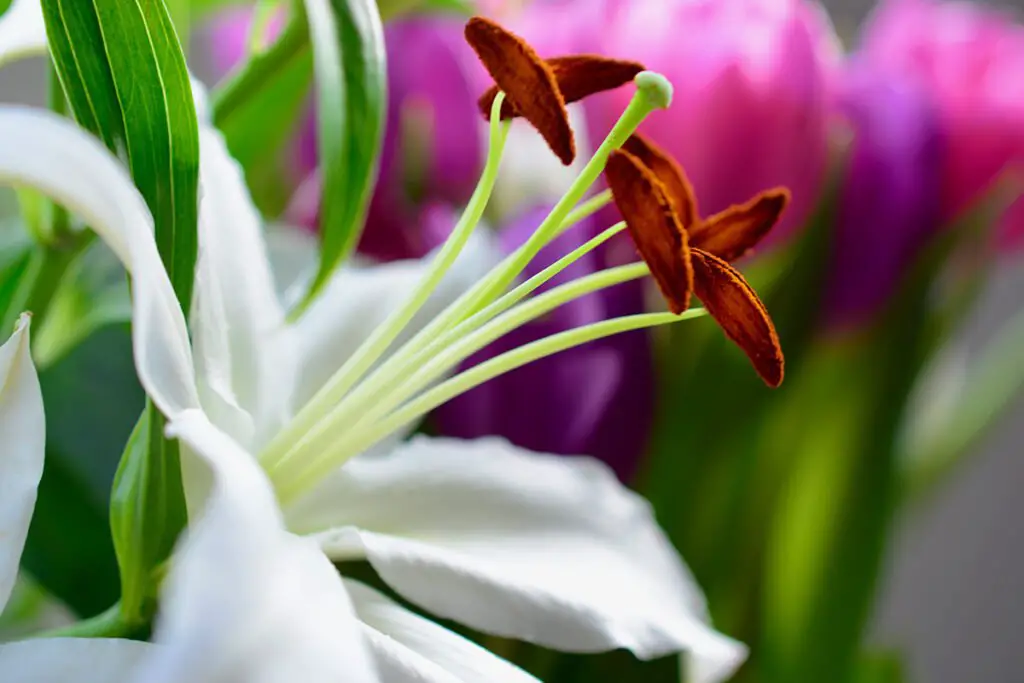
Shield Them from Extreme Temperatures
Extreme temperatures can spell trouble for your precious Easter lily plants. Frosty winters or scorching heatwaves can damage their delicate bulbs and hinder their growth. It's crucial to shield them from these harsh conditions to ensure their well-being.
During cold winter months, make sure you bring your potted Easter lilies indoors or protect them with a frost cloth if planted in the ground. Exposure to freezing temperatures can cause irreparable damage to their bulbs and inhibit new growth when spring arrives.
Similarly, excessive heat can be detrimental to Easter lilies. If you live in an area prone to heatwaves during summer, consider providing some shade or using a shade cloth to protect your plants. Adequate airflow and regular watering will also help keep the soil temperature in check.
Transitioning from Indoors to Outdoors
If you've been nurturing your Easter lilies indoors and plan to move them outside, it's essential to acclimate them gradually. Sudden changes in lighting and temperature can shock the plants, leading to stress and potential wilting.
Begin by placing your potted Easter lilies in a sheltered outdoor spot where they receive partial sunlight for a few hours each day. Gradually increase their exposure to direct sunlight over several days or weeks, depending on the weather conditions.
Keep a close eye on both daytime and nighttime temperatures during this transition period. Cooler nighttime temperatures around 50°F (10°C) are beneficial for bud formation and can help prolong the duration of blooming. If temperatures drop below this threshold, consider bringing your lilies indoors temporarily until conditions improve.
Avoid Heat Sources That Cause Stress
While Easter lilies appreciate warmth, it's crucial to avoid placing them near heat sources that can cause stress or premature wilting. Keep them away from radiators, heating vents, or any other appliances that emit excessive heat.
High temperatures can accelerate moisture loss from the bulbs and leaves, leading to dehydration and potential damage. Maintaining a moderate temperature range between 60°F (15°C) and 75°F (24°C) will provide optimal growing conditions for your Easter lilies.
Remember that these beautiful flowers are sensitive to abrupt changes in temperature. Therefore, ensure a stable environment without extreme fluctuations that could negatively impact their growth.
Extending the Blooming Period of Easter Lilies in Outdoor Settings
Are you a fan of the stunning blossoms that adorn your garden during the holiday season? If so, you're likely familiar with the charm and elegance of Easter lily plants. These spring bulbs bring joy and beauty to our outdoor spaces with their delicate white petals and heavenly fragrance. To make the most of these magnificent flowers, it's essential to know how to extend their blooming period in outdoor settings.
Promptly Deadhead Faded Flowers
One effective way to prolong the blooming period of your Easter lily plants is by deadheading faded flowers promptly. When a flower begins to fade, it starts directing its energy towards seed production rather than bulb development. By removing these faded flowers, also known as spent blooms, you redirect that energy back into the bulb, encouraging further growth and potential blooms.
To deadhead an Easter lily plant, simply locate the spent bloom where it connects to the stem. Gently pinch or cut off this faded flower using clean pruning shears or your fingers. Be careful not to damage any emerging buds or healthy foliage nearby. By consistently deadheading faded flowers throughout the blooming period, you can encourage your Easter lilies to produce more blossoms and extend their beauty well into early summer.
Maintain Attractive Appearance by Removing Yellowing Leaves
To ensure your Easter lilies maintain an attractive appearance while extending their blooming period, it's important to remove yellowing leaves promptly. As these plants age or experience stress from environmental factors like heat or disease, some leaves may turn yellow and detract from their overall aesthetic appeal.
By removing these yellowing leaves close to their base using clean pruners or scissors, you not only improve the visual appeal but also reduce the risk of disease. Yellowing leaves can be a sign of fungal or bacterial infections, and removing them promptly helps prevent the spread of these pathogens to healthy parts of the plant.
Apply Balanced Liquid Fertilizer for Continuous Flower Production
Supporting your Easter lilies with proper nutrition is crucial to ensure continuous flower production throughout their blooming period. Applying a balanced liquid fertilizer during this time provides essential nutrients that promote healthy growth and abundant blooms.
Look for a fertilizer specifically formulated for flowering plants and follow the manufacturer's instructions for application rates. Generally, it is recommended to dilute the fertilizer in water and apply it directly to the soil around the base of the plant. This allows the roots to absorb the nutrients effectively.
Regularly feeding your Easter lilies with a balanced liquid fertilizer every few weeks during their blooming period will help sustain their energy levels, resulting in prolonged blossoms that bring joy and delight to your garden.
Mulching Helps Regulate Soil Temperature and Moisture
Mulching around your Easter lily plants offers several benefits that contribute to extending their blooming time. By applying a layer of organic mulch, such as shredded bark or compost, you create an insulating barrier that helps regulate soil temperature.
During early spring when frost may still occur, mulch acts as a protective blanket, shielding the bulbs from potential damage caused by freezing temperatures. As summer approaches, mulch helps keep the soil cool and prevents excessive moisture evaporation, ensuring optimal growing conditions for your Easter lilies.
In addition to temperature regulation and moisture conservation, mulching also suppresses weed growth around your plants. Weeds compete with Easter lilies for essential resources like water and nutrients. By suppressing weeds through mulching, you provide your lilies with an advantage in accessing these vital elements needed for prolonged blooming.
Consider Planting Early-, Mid-, and Late-Season Varieties
If you're eager to enjoy Easter lilies' beauty throughout the summer, consider planting a variety of bulbs with staggered blooming times.
Dealing with Pests and Diseases Affecting Outdoor Easter Lilies
Pesky Pests: Aphids, Mites, Slugs, and Snails
Dealing with pests can be a real pain in the petals. These beautiful plants are prone to attracting unwanted visitors such as aphids, mites, slugs, and snails. These critters can wreak havoc on your lilies if left unchecked.
To combat these garden invaders, there are a few options at your disposal. One approach is to use organic insecticides specifically designed for controlling pests on plants. These products are safe for the environment while effectively eliminating the bugs that pose a danger to your Easter lilies.
Alternatively, you can take matters into your own hands by manually removing the pests from your plants. This may involve squishing aphids or picking off snails and slugs one by one. While it may not be the most glamorous task, it can be an effective way to keep these pesky creatures at bay.
Disease Prevention: Botrytis Blight and Gray Mold
In addition to pests, diseases can also pose a problem for outdoor Easter lilies. One common disease that affects these plants is botrytis blight. This fungal infection thrives in damp conditions and can quickly spread throughout your garden if not properly addressed.
To prevent botrytis blight from taking hold of your Easter lilies, it's important to provide good air circulation around the plants. Avoid overcrowding them and ensure they have enough space between each other for proper airflow. Overhead watering should be avoided as it creates a moist environment that encourages the growth of this disease.
Another fungal infection that can affect outdoor Easter lilies is gray mold. This pesky fungus causes browning and wilting of leaves and stems, eventually leading to stem rot if left untreated. To minimize the risk of gray mold, practicing proper sanitation is crucial. Remove any infected plant parts promptly and dispose of them properly to prevent the spread of the disease.
Vigilance is Key: Regular Inspections and Preventive Measures
Vigilance is key. Regularly inspecting your plants for signs of pest infestation or disease can help you address any issues promptly before they become major problems.
Keep an eye out for telltale signs such as yellowing leaves, distorted growth, or evidence of pests like aphids or slugs. If you spot any issues, take immediate action to nip them in the bud. This could involve applying organic insecticides or manually removing pests from your plants.
In addition to regular inspections, applying preventive measures can also help protect your Easter lilies from pests and diseases. Products like neem oil or horticultural soap can act as a barrier against common garden invaders. By regularly treating your plants with these preventive solutions, you can create a hostile environment for pests while keeping your Easter lilies healthy and vibrant.
Steps to Take After Easter Lily Blooms Fade: Replanting or Overwintering?
Allow the foliage to naturally yellow and wither before cutting it back to promote bulb maturation.
When your Easter lily blooms start to fade, it's important to allow the foliage to go through its natural process. The leaves will gradually turn yellow and wither away. This may take a few weeks, but it's crucial not to rush this stage. By allowing the foliage to die back on its own, you are giving the bulbs the time they need to store up energy for future growth.
Once the leaves have completely yellowed and withered, you can proceed with cutting them back. Use a clean pair of garden shears or scissors and carefully trim the foliage down to about an inch above the soil level. Be sure not to cut into the bulb itself as this could damage it. Trimming back the foliage after it has turned yellow helps redirect energy towards bulb maturation.
Decide whether to replant bulbs immediately after foliage dies back or store them for overwintering indoors.
After you've cut back the faded foliage, you have two options: replanting your Easter lily bulbs immediately or storing them for overwintering indoors. The choice depends on your preferences and growing conditions.
If you decide to replant your bulbs right away, choose a new location that offers similar growing conditions as before. Easter lilies prefer well-draining soil in a sunny spot with partial shade during hot summer months. Prepare the soil by adding organic matter, such as compost or peat moss, which will improve drainage and provide essential nutrients for healthy growth.
On the other hand, if you live in an area where winters are harsh or if you lack suitable outdoor space for replanting, overwintering your Easter lily bulbs indoors is a great alternative. This method allows you to protect your bulbs from freezing temperatures while still ensuring their health for future seasons.
If replanting, choose a new location with similar growing conditions and prepare the soil accordingly.
If you've decided to replant your Easter lily bulbs immediately after the foliage dies back, it's essential to select a new location that meets their growing requirements. Look for an area in your garden that receives full sun or partial shade during the day. The soil should be well-draining to prevent waterlogging, which can lead to bulb rot.
Before planting, take some time to prepare the soil. Start by removing any weeds or debris from the area. Then, dig a hole that is deep enough to accommodate the bulb without crowding its roots. Gently place the bulb in the hole with the pointed end facing up and cover it with soil. Water thoroughly after planting to settle the soil around the bulb.
To give your Easter lilies an extra boost, consider adding organic matter like compost or well-rotted manure when preparing the soil. This will provide additional nutrients and improve drainage, ensuring optimal growth and blooming in future seasons.
For overwintering, carefully dig up bulbs, remove excess soil, and store in a cool, dry place until spring planting.
If you opt for overwintering your Easter lily bulbs indoors instead of replanting them immediately after foliage dies back, follow these steps to ensure their safe storage:
- Wait until all foliage has completely yellowed and withered before digging up the bulbs.
- Carefully loosen the soil around each bulb using a garden fork or shovel.
- Gently lift out each bulb without damaging its delicate roots.
- Shake off excess soil from each bulb but avoid washing them as moisture can promote rotting.
- Inspect each bulb for any signs of damage or disease; discard any that appear unhealthy.
- Find a cool and dry place where you can store your bulbs until spring. A basement, garage, or unheated room with temperatures around 40-50°F (4-10°C) is ideal.
- Place the bulbs in a container filled with dry peat moss, vermiculite, or sawdust to keep them from drying out.
- Check on your stored bulbs occasionally throughout winter to ensure they remain firm and healthy.
Transitioning Indoor Easter Lilies to Outdoor Environments
So, you've been enjoying the vibrant beauty of your indoor Easter lily plants, but now you're wondering how to transition them to the great outdoors? Well, fear not! With a few simple steps and a little bit of patience, you can successfully move your potted Easter lilies from indoors to the outdoor environment. Let's dive into the process together!
Gradually introduce potted indoor Easter lilies to outdoor conditions
To ensure a smooth transition for your beloved Easter lilies, it's important to start by gradually introducing them to their new outdoor surroundings. Begin by placing the potted plants in a sheltered area, such as a porch or patio. This will provide them with some protection from harsh weather conditions and sudden temperature changes.
By giving your Easter lilies time to acclimate slowly, you help prevent shock and stress on the plants. Remember, they have been thriving in controlled indoor environments and need time to adjust to the elements outside.
Increase exposure to sunlight gradually over several days
One crucial aspect of transitioning indoor Easter lilies outdoors is gradually increasing their exposure to sunlight. While these plants love basking in bright light, too much sun too soon can lead to sunburn on their tender leaves.
Start by placing your potted Easter lilies in an area where they receive partial sunlight for a few hours each day. As the days go by, gradually increase their exposure until they are receiving full sun. This step-by-step approach will allow the plants' leaves to build up tolerance and avoid any unwanted sun damage.
Monitor moisture levels closely during the transition period
As you move your indoor Easter lilies outdoors, keep a close eye on their moisture levels. Outdoor conditions may differ significantly from those inside your home or greenhouse. The increased exposure to wind and direct sunlight can cause faster evaporation of water from both soil and foliage.
Make sure to water your Easter lilies more frequently during the transition period. Check the moisture level of the soil regularly, ensuring it remains consistently moist but not overly saturated. This extra attention will help prevent dehydration and keep your plants happy and healthy.
Protect plants from strong winds that can damage delicate stems
Outdoor environments can be unpredictable, especially. Strong gusts can easily damage the delicate stems of your Easter lilies, undoing all your hard work in transitioning them outdoors. To avoid this, take precautions to shield your plants from excessive wind until they have fully acclimated.
Consider placing a temporary barrier or windbreak around your Easter lilies to protect them from strong gusts. This could be as simple as using stakes and garden fabric or even strategically placing larger pots or planters nearby to act as a natural wind buffer.
Transferring indoor Easter lilies outdoors adds beauty to your garden while allowing the plants to thrive
The effort you put into transitioning your indoor Easter lilies outdoors is well worth it when you see their vibrant blooms gracing your garden. Not only do these stunning flowers add beauty and elegance to any outdoor space, but they also thrive in natural sunlight and fresh air.
By giving your Easter lilies the opportunity to grow outside, you're providing them with an abundance of energy from sunlight, which helps fuel their growth and development. Being exposed to natural elements allows these plants to establish stronger root systems, making them more resilient overall.
So, why not give it a try? Transitioning your indoor Easter lilies outdoors is a rewarding process that brings joy and color to both you and your garden!
Remember: Take it slow, protect them from harsh conditions at first, gradually increase sunlight exposure, monitor moisture levels closely during the transition period, shield them from strong winds until they are fully acclimated—and watch those beautiful blooms flourish in their new outdoor home!
Incorporating Easter Lilies into Garden Designs: Tips and Ideas
Plant Easter lilies among other perennials with complementary colors for an eye-catching display.
Incorporating Easter lilies is a good idea. These beautiful flowers can add a touch of elegance and vibrancy to your outdoor space. To make the most of their beauty, consider planting Easter lilies among other perennials that have complementary colors. This will create an eye-catching display that will surely impress your neighbors and guests.
Imagine a garden bed filled with vibrant red tulips, delicate purple irises, and the pure white blooms of Easter lilies. The contrasting colors will create a visual feast for the eyes. You can also mix in some yellow daffodils or pink peonies to add even more variety to the color palette.
To achieve the best results, pay attention to the height and growth habit of each plant. Place taller perennials like irises or peonies towards the back of the bed, with Easter lilies in front or interspersed throughout. This layering effect will give your garden depth and dimension while ensuring that each plant gets enough sunlight.
Consider using containers if you have limited garden space or want the flexibility to move your Easter lilies.
If you're short on garden space or simply prefer more flexibility in arranging your plants, using containers for your Easter lilies is a great option. Not only does it allow you to grow these stunning flowers in smaller areas such as balconies or patios, but it also gives you the freedom to rearrange them whenever you feel like refreshing your outdoor space.
Choose containers that are deep enough to accommodate the roots of your Easter lily plants. A container at least 12 inches deep should be sufficient for most varieties. Make sure there are drainage holes at the bottom to prevent waterlogging, which can lead to root rot.
When planting Easter lilies in containers, use a well-draining potting mix and place the bulbs about 6 inches apart. This will give them enough space to grow and prevent overcrowding. Water the plants regularly, ensuring that the soil remains moist but not waterlogged. Remember to fertilize them every few weeks during the growing season to promote healthy growth and abundant blooms.
Create a focal point by planting Easter lilies in groups or rows, enhancing the overall visual impact.
To make a bold statement with your Easter lilies, consider planting them in groups or rows to create a focal point in your garden. By clustering several plants together, you can enhance their overall visual impact and draw attention to their stunning blooms.
For example, you could plant three or five Easter lily bulbs in a triangular pattern at the center of a flower bed. This arrangement will create a focal point that immediately catches the eye. Alternatively, you can plant them in rows along a walkway or border for a more structured look.
To ensure that your Easter lilies stand out even more, consider placing them against a backdrop of contrasting foliage or flowers. For instance, plant them against dark green shrubs or colorful annuals like marigolds or petunias. This contrast will make their pure white flowers pop and add an extra layer of visual interest to your garden design.
Combine different varieties of Easter lilies to extend the blooming period and add variety to your garden.
If you want your garden to be filled with beautiful blooms throughout the entire spring season, combining different varieties of Easter lilies is an excellent idea. By selecting early-, mid-, and late-blooming varieties, you can extend the blooming period and enjoy these stunning flowers for longer.
Start by choosing early-blooming varieties such as 'Nellie White' or 'Yelloween' for their captivating beauty in March or April. As their blooms start to fade, mid-blooming varieties like 'Robina' or 'White Fox' will take over, ensuring a seamless transition of colors and fragrances in your garden. Finally, late-blooming varieties such as 'Regale' or 'African Queen' can continue the show well into May.
By incorporating different Easter lily varieties, you not only extend the blooming period but also add variety and interest to your garden. Each variety has its own unique characteristics, from flower shape and size to fragrance and stem height. This diversity will create a dynamic and ever-changing landscape that keeps your garden visually appealing throughout the season.
Incorporating Easter lilies into garden designs adds elegance and fragrance to your outdoor space.
Incorporating Easter lilies into your garden designs is more than just a visual choice; it's also about adding elegance and fragrance to your outdoor space. These stunning flowers have long been associated with beauty and purity, making them a perfect addition to any garden.
Maximizing the Beauty of Outdoor Easter Lily Plants
To make the most of your outdoor Easter lily plants, there are several key factors to consider. By understanding their blooming cycle, providing optimal growing conditions, and taking steps to combat pests and diseases, you can ensure that your Easter lilies thrive in an outdoor setting. Transitioning indoor Easter lilies to the outdoors and incorporating them into garden designs can enhance the overall beauty of your landscape.
Choosing the Right Location for Outdoor Easter Lily Plants
Selecting the right location is crucial for the success of your outdoor Easter lily plants. Choose a spot that receives partial shade or filtered sunlight, as direct sunlight can scorch their delicate blooms. Ensure that the area has well-draining soil to prevent waterlogging.
Understanding the Blooming Cycle of Easter Lilies
By familiarizing yourself with the blooming cycle of Easter lilies, you can better care for them throughout each stage. From planting bulbs in early spring to enjoying their stunning flowers in summer, understanding when and how they bloom will help you maximize their beauty.
Planting Easter Lilies Outside: Best Practices and Techniques
When planting Easter lilies outside, it's important to follow best practices and techniques. Dig a hole deep enough for the bulb and ensure proper spacing between plants. Adding organic matter to improve soil fertility and drainage is also beneficial.
Providing Optimal Soil and Water Conditions for Outdoor Easter Lilies
To promote healthy growth, provide optimal soil and water conditions for your outdoor Easter lilies. They prefer slightly acidic soil with good moisture retention but must not be overwatered. Regularly check soil moisture levels before watering.
Ensuring Proper Lighting and Temperature for Healthy Easter Lily Growth
Proper lighting and temperature are essential for healthy growth of outdoor Easter lilies. Aim for a location where they receive bright but indirect light during most parts of the day. Maintain temperatures between 60-70°F (15-21°C) during the day and slightly cooler at night.
Extending the Blooming Period of Easter Lilies in Outdoor Settings
To extend the blooming period of your outdoor Easter lilies, consider staggering their planting times or selecting different varieties with varying bloom times. Deadheading spent flowers and providing adequate nutrition can also encourage prolonged blooming.
Dealing with Pests and Diseases Affecting Outdoor Easter Lilies
Pests and diseases can pose a threat to outdoor Easter lilies. Keep an eye out for common issues like aphids, snails, and fungal diseases. Regular inspection, proper sanitation, and using organic pest control methods when necessary can help keep your plants healthy.
Steps to Take After Easter Lily Blooms Fade: Replanting or Overwintering?
After the blooms of your outdoor Easter lilies fade, you have options for what to do next. You can either replant new bulbs each year or overwinter existing bulbs by cutting back foliage and storing them in a cool, dry place until the following spring.
Transitioning Indoor Easter Lilies to Outdoor Environments
If you have indoor Easter lilies that you want to transition outdoors, it's important to acclimate them gradually. Start by placing them in a sheltered area outside for short periods before gradually increasing their exposure to sunlight and outdoor conditions.
Incorporating Easter Lilies into Garden Designs: Tips and Ideas
Easter lilies can be stunning additions to garden designs. Consider planting them alongside other spring-blooming flowers like tulips or daffodils for a vibrant display. Their tall stems make them great focal points in flower beds or borders.
By following these guidelines and understanding how to maximize the beauty of your outdoor Easter lily plants, you can enjoy their stunning blooms throughout the season while creating an enchanting landscape filled with color and fragrance.
FAQs: Easter Lily Plants - Tips for Outdoor Growth
Q: How often should I water outdoor Easter lily plants?
A: Outdoor Easter lilies should be watered when the top inch of soil feels dry. Avoid overwatering, as it can lead to root rot.
Q: Can I grow Easter lilies in containers?
A: Yes, you can grow Easter lilies in containers. Ensure the container has drainage holes and use a well-draining potting mix. Follow the same care guidelines as for outdoor planting.
Q: Do Easter lilies attract bees?
A: Yes, Easter lilies are known to attract bees due to their fragrance and nectar. If you have concerns about bee allergies or prefer to minimize bee activity, consider planting them away from frequently used areas.
Q: How long do outdoor Easter lilies bloom?
A: The blooming period of outdoor Easter lilies typically lasts 2-3 weeks. By deadheading spent flowers and providing proper care, you may extend the blooming period slightly.
Q: Are outdoor Easter lily plants toxic to pets?
A: Yes, all parts of the Easter lily plant are toxic to cats and can cause kidney failure if ingested. Keep them out of reach of pets or opt for pet-friendly alternatives in your garden.
Image Source: Paid image from CANVA

